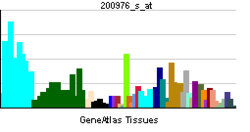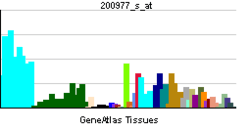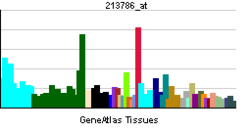TAX1BP1
Tax1-binding protein 1 is a protein that in humans is encoded by the TAX1BP1 gene.[3]
Interactions
TAX1BP1 has been shown to interact with TNFAIP3[4] and TRAF6.[5] TAX1BP1 binds to TNFAIP3 or TRAF6 and suppresses NF-kappaB transcriptional activation.
References
Further reading
- "Toward a complete human genome sequence". Genome Res. 8 (11): 1097–108. 1999. doi:10.1101/gr.8.11.1097. PMID 9847074.
- De Valck D, Jin DY, Heyninck K, et al. (1999). "The zinc finger protein A20 interacts with a novel anti-apoptotic protein which is cleaved by specific caspases". Oncogene. 18 (29): 4182–90. doi:10.1038/sj.onc.1202787. PMID 10435631.
- Ling L, Goeddel DV (2000). "T6BP, a TRAF6-interacting protein involved in IL-1 signaling". Proc. Natl. Acad. Sci. U.S.A. 97 (17): 9567–72. doi:10.1073/pnas.170279097. PMC 16905
 . PMID 10920205.
. PMID 10920205.
- Hartley JL, Temple GF, Brasch MA (2001). "DNA Cloning Using In Vitro Site-Specific Recombination". Genome Res. 10 (11): 1788–95. doi:10.1101/gr.143000. PMC 310948
 . PMID 11076863.
. PMID 11076863.
- Wiemann S, Weil B, Wellenreuther R, et al. (2001). "Toward a Catalog of Human Genes and Proteins: Sequencing and Analysis of 500 Novel Complete Protein Coding Human cDNAs". Genome Res. 11 (3): 422–35. doi:10.1101/gr.GR1547R. PMC 311072
 . PMID 11230166.
. PMID 11230166.
- Klinkenberg M, Van Huffel S, Heyninck K, Beyaert R (2001). "Functional redundancy of the zinc fingers of A20 for inhibition of NF-kappaB activation and protein-protein interactions". FEBS Lett. 498 (1): 93–7. doi:10.1016/S0014-5793(01)02504-2. PMID 11389905.
- Dodon MD, Hamaia S, Martin J, Gazzolo L (2002). "Heterogeneous nuclear ribonucleoprotein A1 interferes with the binding of the human T cell leukemia virus type 1 rex regulatory protein to its response element". J. Biol. Chem. 277 (21): 18744–52. doi:10.1074/jbc.M109087200. PMID 11893730.
- Strausberg RL, Feingold EA, Grouse LH, et al. (2003). "Generation and initial analysis of more than 15,000 full-length human and mouse cDNA sequences". Proc. Natl. Acad. Sci. U.S.A. 99 (26): 16899–903. doi:10.1073/pnas.242603899. PMC 139241
 . PMID 12477932.
. PMID 12477932.
- Scherer SW, Cheung J, MacDonald JR, et al. (2003). "Human Chromosome 7: DNA Sequence and Biology". Science. 300 (5620): 767–72. doi:10.1126/science.1083423. PMC 2882961
 . PMID 12690205.
. PMID 12690205.
- Hillier LW, Fulton RS, Fulton LA, et al. (2003). "The DNA sequence of human chromosome 7". Nature. 424 (6945): 157–64. doi:10.1038/nature01782. PMID 12853948.
- Wu K, Bottazzi ME, de la Fuente C, et al. (2004). "Protein profile of tax-associated complexes". J. Biol. Chem. 279 (1): 495–508. doi:10.1074/jbc.M310069200. PMID 14530271.
- Nagaraja GM, Kandpal RP (2004). "Chromosome 13q12 encoded Rho GTPase activating protein suppresses growth of breast carcinoma cells, and yeast two-hybrid screen shows its interaction with several proteins". Biochem. Biophys. Res. Commun. 313 (3): 654–65. doi:10.1016/j.bbrc.2003.12.001. PMID 14697242.
- Colland F, Jacq X, Trouplin V, et al. (2004). "Functional Proteomics Mapping of a Human Signaling Pathway". Genome Res. 14 (7): 1324–32. doi:10.1101/gr.2334104. PMC 442148
 . PMID 15231748.
. PMID 15231748.
- Suzuki Y, Yamashita R, Shirota M, et al. (2004). "Sequence Comparison of Human and Mouse Genes Reveals a Homologous Block Structure in the Promoter Regions". Genome Res. 14 (9): 1711–8. doi:10.1101/gr.2435604. PMC 515316
 . PMID 15342556.
. PMID 15342556.
- Gerhard DS, Wagner L, Feingold EA, et al. (2004). "The Status, Quality, and Expansion of the NIH Full-Length cDNA Project: The Mammalian Gene Collection (MGC)". Genome Res. 14 (10B): 2121–7. doi:10.1101/gr.2596504. PMC 528928
 . PMID 15489334.
. PMID 15489334.
- Wiemann S, Arlt D, Huber W, et al. (2004). "From ORFeome to Biology: A Functional Genomics Pipeline". Genome Res. 14 (10B): 2136–44. doi:10.1101/gr.2576704. PMC 528930
 . PMID 15489336.
. PMID 15489336.
- Mehrle A, Rosenfelder H, Schupp I, et al. (2006). "The LIFEdb database in 2006". Nucleic Acids Res. 34 (Database issue): D415–8. doi:10.1093/nar/gkj139. PMC 1347501
 . PMID 16381901.
. PMID 16381901.
- Morriswood B, Ryzhakov G, Puri C, et al. (2007). "T6BP and NDP52 are myosin VI binding partners with potential roles in cytokine signalling and cell adhesion". J. Cell. Sci. 120 (Pt 15): 2574–85. doi:10.1242/jcs.007005. PMC 2621013
 . PMID 17635994.
. PMID 17635994.



 . PMID 10920205.
. PMID 10920205. . PMID 10920205.
. PMID 10920205. . PMID 11076863.
. PMID 11076863. . PMID 11230166.
. PMID 11230166. . PMID 12477932.
. PMID 12477932. . PMID 12690205.
. PMID 12690205. . PMID 15231748.
. PMID 15231748. . PMID 15342556.
. PMID 15342556. . PMID 15489334.
. PMID 15489334. . PMID 15489336.
. PMID 15489336. . PMID 16381901.
. PMID 16381901. . PMID 17635994.
. PMID 17635994.